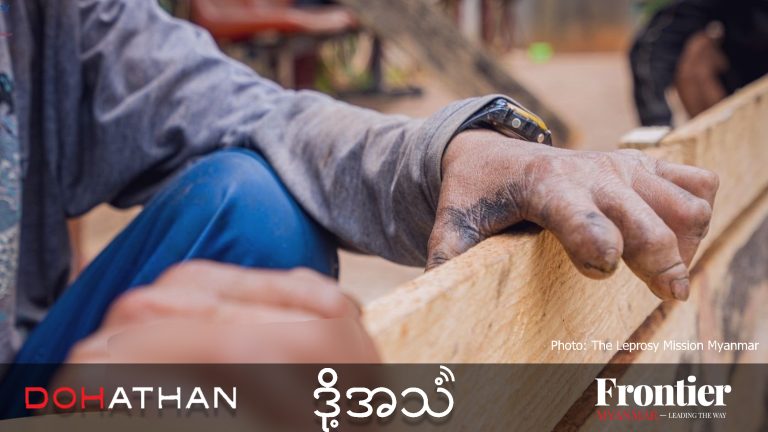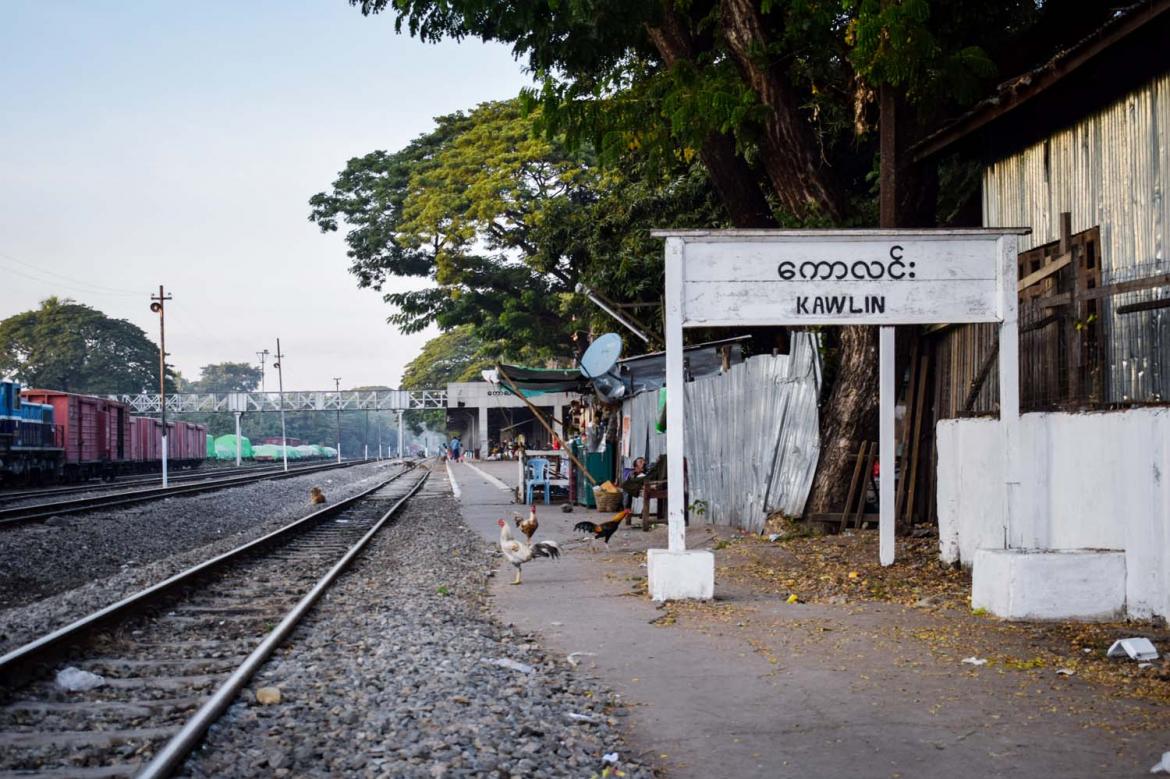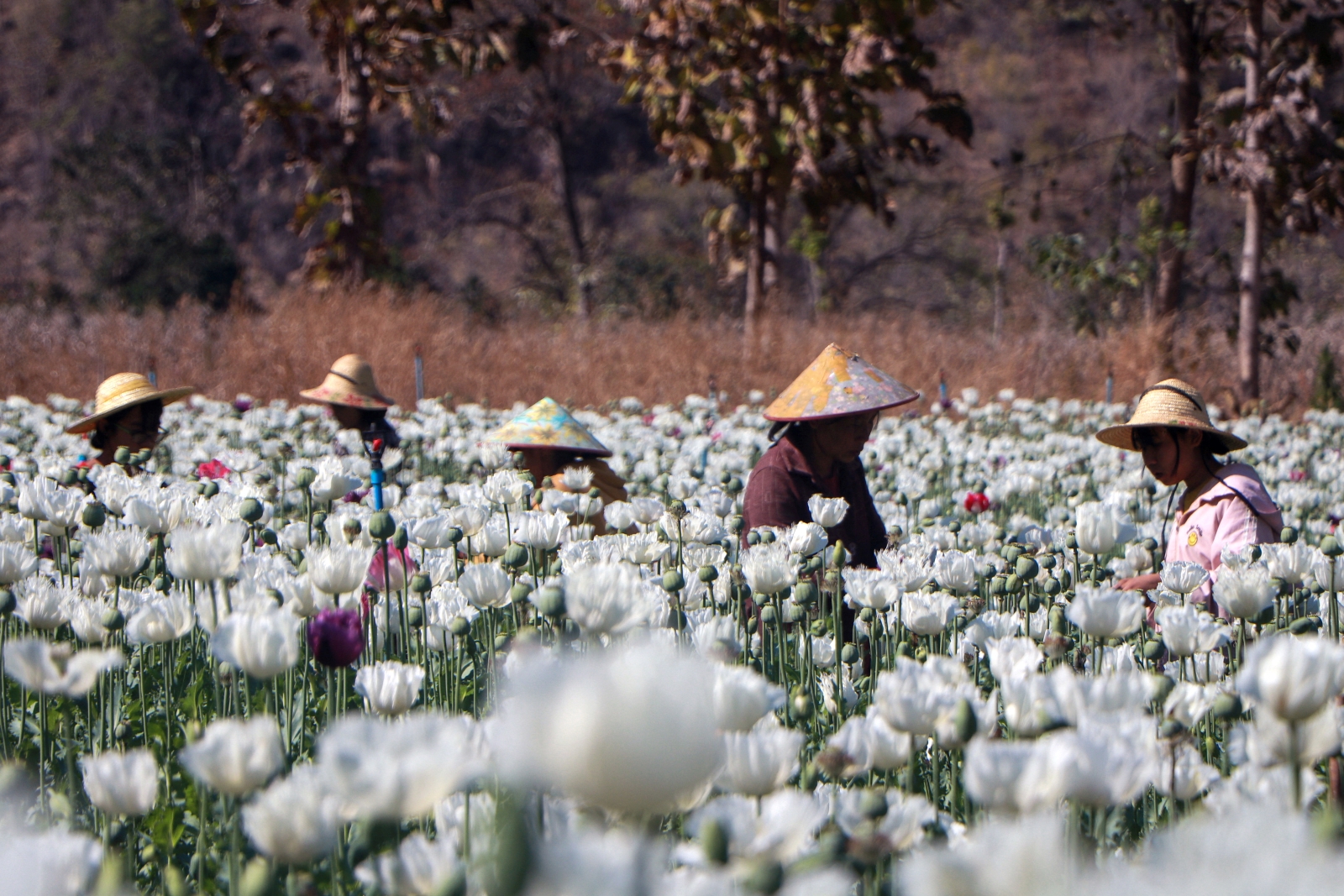Traditional weavers in the central Dry Zone and Chin State are struggling to make a living amid conflict and displacement, while shortages of labour, electricity and demand are hampering the wider industry.
By FRONTIER
Several hundred men and women carrying tarpaulins, bags and bamboo baskets filled with kitchenware trudged along the main street of Myit Chay Phyar village at dawn. They were returning home two days after fleeing a July 12 attack by pro-junta paramilitary forces.
“We sought safety in the palm groves, sleeping on tarpaulins under the trees,” said Ma Nyein Nyein*.
She said it wasn’t the first time she and her neighbours have had to abandon their village in Magway Region’s Pakokku Township. Repeated raids in the area since last September have forced her to flee several times, disrupting her livelihood as a weaver.
“Sometimes we couldn’t go back to the village for four or five days. If we had food, we ate, otherwise we went hungry. Things calmed down after [the April festival of] Thingyan but now we’ve had to flee again,” she told Frontier.
The Myanmar military seized power in February 2021, sparking a political crisis and broadening civil war. Resistance groups known as People’s Defence Forces have taken up arms against the new junta, while pro-regime militias called Pyusawhti have emerged, particularly in the country’s central Dry Zone, which includes Magway.
Nyein Nyein has been a traditional weaver for the past four years, since she and her husband gave up making and selling palm sugar. That work was tough and with one viss (1.63kg) of palm sugar only making K400 (US$0.2), they had to find a better way to survive.
So, she decided to follow family custom and took up the loom.
Weavers in the Dry Zone used to start with the raw materials, turning raw cotton into yarn which they then dye and weave into the final product. Now, however, they mostly work with pre-prepared yarn. Nyein Nyein said she receives cotton thread from wholesalers and turns it into two-metre-long shawls that she sells for K2,000 each.
Sometimes she gets so many orders that she delegates work to other weavers in her village tract, where about 100 people work by hand and with looms.
But the conflict is making it increasingly difficult for them to sustain their livelihoods, said Nyein Nyein.
“I received an order for 200 shawls but I have only been able to complete 50 so far. Even if I work constantly it may take up to three months to finish them all, as I can only manage to complete one a day. It would be a tremendous relief if I didn’t have to flee so often and could just focus on my work,” she said.

In September last year, two other villages in her village tract were raided by the Tatmadaw, resulting in the burning of approximately 150 houses.
Nyein Nyein’s village has been spared from arson so far, but its residents live in constant fear and usually flee to the forest when clashes break out nearby. Even during quiet periods, many don’t dare to travel to other villages and towns to avoid dangerous encounters with soldiers and militiamen.
Other weaving villages haven’t been as lucky. On February 23, junta forces attacked Htoo Gyi and Moo Kam Gyi villages, about 200 kilometres to the north in Sagaing Region’s Shwebo Township. Local disaster relief organisation S&C said more than 100 looms were destroyed in junta arson attacks in both villages.
“We have managed to re-construct 30 handlooms with the support of donors, but it’s not enough given the extent of the losses. The reality is that many of the weavers may not be able to resume their businesses,” an S&C relief worker told Frontier.
In Chin State, which borders Magway to the west and has also been battered by the post-coup conflict, many are turning to traditional back-strap loom weaving using wooden and bamboo sticks. This is because of limited job opportunities as well as an increase in demand for traditional clothes among the Chin diaspora elsewhere in Myanmar and abroad, whose numbers have swollen since the coup.
Chin textiles are known for their intricate geometrical patterns and vivid colours. They take longer to make and are usually more resistant and of a finer quality, meaning they sell for higher prices than textiles in central Myanmar.
Daw Ngun* from Chin’s Hakha Township said she took to traditional backstrap weaving when her husband lost his livelihood. He had supported the family by writing Christian hymns for local churches but lost most of his clients at the onset of the COVID-19 pandemic in 2020 and never got them back.
She told Frontier it takes her a month to complete a standard order of a shawl and a longyi, the traditional Myanmar lower garment, which earns her K120,000 (US$57). She said that with the price of rice and other necessities rising, the money was barely enough to provide for her, her unemployed husband and their three children, aged five to 12.

Rising costs, falling profits
Besides conflict, Myanmar’s weaving industry is also suffering from a labour shortage due to migration as well as power cuts and a decrease in demand amid an economic crisis.
These have affected not just artisan weavers, but big firms as well.
“Many people have left the country because they are struggling to make a living, and this has resulted in a severe labour shortage,” said Ko Toe Gyi*, the owner of a wholesale clothing business in Mandalay Region’s Wundwin Township. “Currently only 50 percent of weaving businesses in Wundwin can operate effectively.”
“I thought of leaving too, but I have to stay because my husband is getting older,” said Daw Ngun, who added that the cost of moving and finding a job in Malaysia is about K4.5 million.
But despite the high migration costs, the representative of a major textile company, who spoke to Frontier on the condition of anonymity, said increasing numbers of people from Chin were leaving Myanmar, creating labour shortages for her enterprise.
Besides workers, electricity is also in short supply, further eroding the capacity of businesses.
Despite a clear drop in demand due to falling incomes, Toe Gyi said large-scale weaving businesses are still struggling to deliver orders on time due to widespread blackouts.
“The shortage of electricity has damaged operations. Those operating multiple looms now face challenges,” he said. “With the power cuts, they have to rely on generators, meaning additional costs for diesel.”
In addition, a scarcity of dollars caused by the junta’s attempts to shore up its foreign reserves has led to a reduction in imports of cotton thread. Along with a steep fall in the value of the kyat since the coup, this has driven up the cost of producing textiles by 30pc. Meanwhile, the need to compete with overseas imports means they can’t pass on the cost to the consumer, Toe Gyi said.
“We have to sell our products K500 cheaper than imported longyis. If we raise the price, buyers will prefer to buy foreign products,” he explained, referring to the higher quality of imported clothes.
“The weavers themselves prefer working with cheap cotton thread in large quantities, because the work can be completed more quickly,” he said, explaining that this degrades the quality of the final product. “We have no choice but to accept whatever quality they can deliver.”
Using locally produced cotton thread, which is less common, is even more expensive. The owner of a threads factory in Sagaing said it sold for K1,000 per viss before the pandemic but the price had since doubled.
Ma Moh Moh, a textile wholesaler in Yangon’s Thaketa Township, said this along with the difference in quality had helped imported clothes take over the market.
“People increasingly prefer imported foreign garments,” she said, adding that this was endangering the domestic industry. “The costs of production now exceed the profits.”
* indicates use of a pseudonym for security reasons







